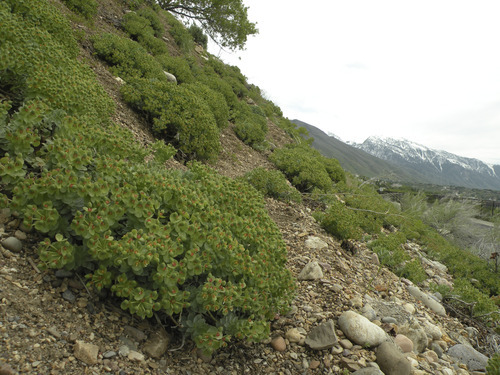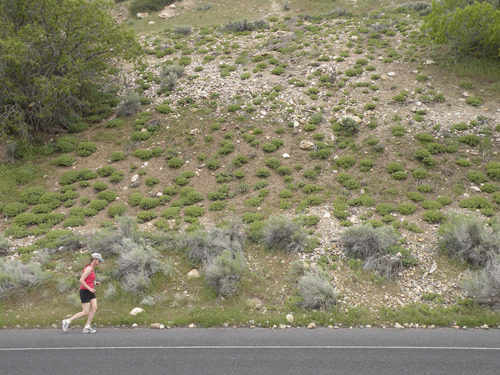This is an archived article that was published on sltrib.com in 2011, and information in the article may be outdated. It is provided only for personal research purposes and may not be reprinted.
As the poisonous weed known as myrtle spurge creeps higher into the mountains from Salt Lake County's east bench, land managers are hoping residents will join them in an escalated fight against the invasion.
"If we don't get some kind of control over how extensively it's spreading, it has the potential to impact wildlife and could contribute to erosion issues," said Sage Fitch, spokeswoman for Salt Lake County's weed control division.
This summer, Salt Lake County is using a federal grant to offer more chances for residents to trade their pulled spurge for native plants. Residents may bring bags of spurge every Friday to the county public works building in Midvale and claim vouchers for native plants to be distributed in September for fall planting. Previously, the county offered just one day of weed exchange.
"People who have extensive infestations weren't able to pull it all out at one time," Fitch said.
Myrtle spurge, a Mediterranean succulent, was introduced decades ago as an attractive, drought-tolerant ornamental plant for landscaping.
But as its profuse seed pods burst year after year, the plant escaped yards and parking strips and got into public lands and green space, Fitch said.
"It just covers an area and forms a really thick mat," she said. "It becomes the dominant vegetation, and it displaces native plants, which displaces wildlife."
Though myrtle spurge grows vigorously on hot, dry slopes, its taproot does not stabilize soil as well as native shrubs, Fitch said. That can create erosion hazards in the foothills where it grows.
Also dangerous is the milky sap that oozes out of the stems and leaves when the plant is broken, Fitch said. It causes rashes and blisters and can become a medical emergency if it makes contact with a person's eye.
"There are kids who have been especially sensitive," Fitch said.
That was what started Ying-Ying Macauley's crusade against the plant carpeting her Millcreek Canyon neighborhood.
"We moved in, and I thought, 'Oh, these yellow flowers on the hill are so gorgeous,' until one day my daughter went up the hill to play. She came back to the house with a big blister on her forehead. It was the size of a thumbnail, just bulging," Macauley said.
That was six years ago. Now that her sloping yard is mostly cleared of the weed, she has moved on to the neighbors' yards.
"When the seed pods pop, they send the seeds 15 feet," Macauley said. "Even though my hill looks nice, I was being attacked on both sides."
Macauley passed around fliers from the county weed control office and several of her neighbors have joined the fight, she said.
"It has been extremely difficult," she said. "I spend hundreds of hours each year battling this plant. The entire hill is infested with spurge."
That's the situation Fitch hopes residents can prevent. Myrtle spurge is on the county's noxious weed list, and nurseries no longer may sell it, Fitch said. The most efficient way to eradicate existing plants is to pull or dig the plant out. Wear gloves and long sleeves to avoid contact with the sap, and get at least four inches of the taproot out of the ground, Fitch said. The disturbed soil may contain seeds that will sprout next season, so remain vigilant.
For plants that are wedged between rocks and cannot be pulled, the pesticides 2,4-D and glyphosate have been somewhat successful, Fitch said.
Because pulled plants likely contain seeds, they should be thrown in the garbage or taken to the public works building for the weekly plant exchange, Fitch said. They should not be composted or placed in yard waste bins, as the contents are added to municipal compost and mulch supplies.
ealberty@sltrib.com Summer Spurge exchange
Salt Lake County is offering vouchers for native plants in exchange for bags of spurge each week throughout the summer.
Location • Salt Lake County public works building, 604 W. 6960 South, Midvale
Time • 10 a.m. to 4 p.m. on Fridays; check in at the front desk
Bring • Bags of pulled myrtle spurge
Receive • Vouchers for native plants to be redeemed at a give-away Sept. 16
Limit • Two vouchers per household, initially. Additional vouchers subject to availability







